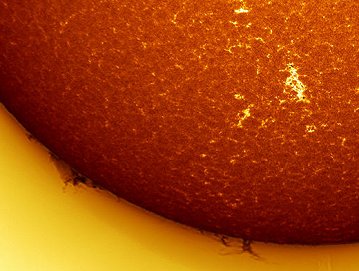 The Perseid meteor shower is coming. Would you like a call when it's time to look? Sign up for Spaceweather PHONE.
The Perseid meteor shower is coming. Would you like a call when it's time to look? Sign up for Spaceweather PHONE.
MOON AND PLEIADES: Set your alarm! Before sunrise on Thursday, July 20th, the crescent Moon will have a beautiful close encounter with the Pleiades star cluster. In some places (the eastern and central USA), the Moon will pass directly in front of the cluster. Wherever you live, look east between 2 and 5 o'clock in the morning: sky map.
ISLAND MEGA-CHAIN: Sunspot 900, a miniscule speck just a few days ago, has blossomed into a chain of spots stretching 40,000 miles from end to end. It's the bright, elongated feature in this photo from Larry Alvarez of Flower Mound, Texas:

Sunspot 900 as seen through a Coronado solar telescope.
On Earth, Pacific island chains sprout up from volcanoes, with lava providing the firmament. On the sun, chains of sunspots sprout up from the sun's inner magnetic dynamo. There is no firmament, only powerful magnetic force fields. Sunspots do, however, have beaches, a white magnetic froth surounding the "island's" darker cores. Solar physicists call it plage (French for beach). The plage of sunspot 900 is beautifully revealed in Alvarez's image, above.
RED vs RED JR: Jupiter's Great Red Spot and Red Jr. are bumping into each other this week. So far, "the great storms are surviving just fine," reports Don Parker of Coral Gables, Florida, who took this picture on July 15th:

Jupiter--the view through a 16-inch telescope.
Extra: You don't need a fancy camera to make a picture of Jupiter. Last night Cai-Uso Wohler of Bispingen, Germany did it using a pencil and paper: drawing. "Red Jr. is now right under the Great Red Spot," says Wohler.

